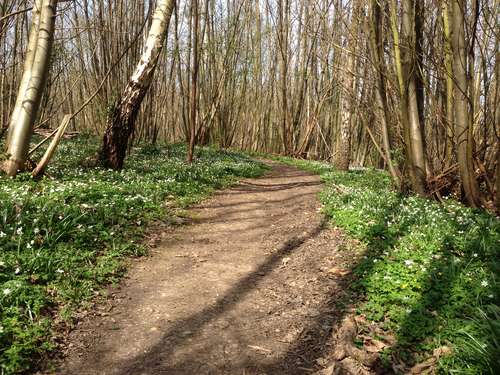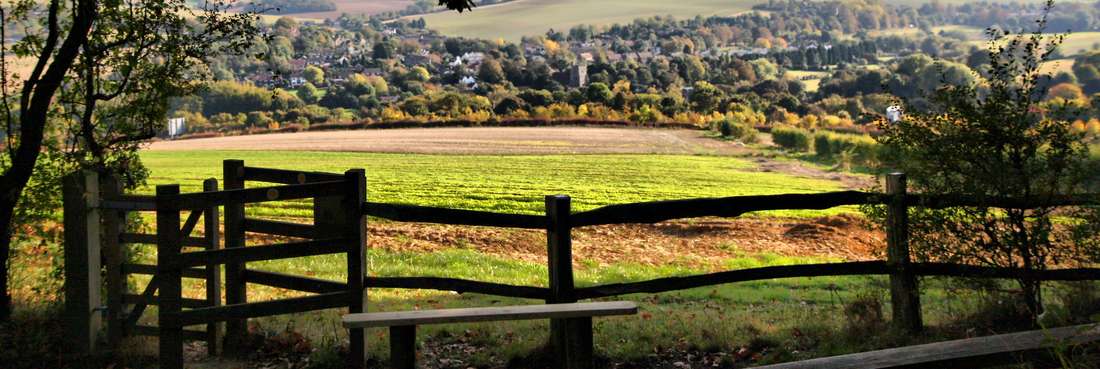About the Wood

Opened by Sir David Attenborough in September 1986, Farningham Woods Nature Reserve sits atop a hill just to the north of Farningham village, and commands views over the Kent countryside all the way to Dartford to the north and Sevenoaks to the south.
It is thought that Calfstock Lane, which leads to the Woods, may have been part of a prehistoric track way that wound across the North Downs. The Woods are listed as ancient woodland, which indicates that it must have been continuously wooded with species like Oak, Ash, Field Maple, Hazel and Birch since at least 1600 AD.
As with many woodlands in the South East, the last 250 years saw the wood being extensively planted with Sweet Chestnut and coppiced on a rotational basis for commercial timber. By the 1960s the timber market drastically declined putting a stop to the traditional coppice management of woodlands. This had a negative effect on the wildlife that favoured the different woodland structures that coppicing produced.
In 1974, Sevenoaks District Council purchased 34 ha of the wood, with the remaining 34 ha being purchased by Farningham Parish Council in 1987. Under this new structure and guidance from woodland consultants, the Forestry Commission and Natural England, a coppicing programme was reinstated to prevent the woodland becoming derelict, and to benefit the Woods' wildlife.
Due to its special character and rich ground flora, the site was designated a Special Site of Scientific Interest in 1951 and a Local Nature Reserve in 1987.
Although predominately Sweet Chestnut coppice, the woods also include an area of heathland, a pond and three unimproved grasslands known as the Folly Fields. The heathland is particularly noteworthy as it is an extremely rare habitat in Kent and expanding its range would provide another important habitat for rare species of wildlife to colonise.

Deptford Pink (Dianthus armeria)
Whilst walking through Farningham Woods keep your eyes peeled for the nationally rare Deptford Pinks (Dianthus armeria). Farningham Woods is home to the largest population found in Britain, and is known to grow at only one other location in Kent!
Keen eyes might also be able to spot notable species such as Lily of the Valley (Convallaria majalis), Solomon's Seal (Polygonatum multiflorum), Small-leaved Lime (Tilia cordata) plus many more. The woods are also home to reptiles and amphibians, including the nationally protected Great Crested Newt (Triturus cristatus), birds like the Lesser Spotted Woodpecker (Dryobates minor) and many butterflies and insects.
It is hoped that the coppicing programme will, one day, provide a suitable habitat for threatened species like the Nightingale (Luscinia megarhynchos) and even the Nightjar (Caprimulgus europaeus)
Coppice Management
The basic feature of a coppiced wood is that it is cut periodically and the trees are allowed to regrow from the cut stumps (known as a 'stool'). A coppiced wood provides a self-renewing source of wood allowing an indefinite number of crops of stems to be taken. Coppiced trees can live to a great age. Some of the oldest trees in British woods are coppice stools which may be more than 1,000 years old.
As the tree already has an established root system the regrowth from the cut stools can be remarkably fast. It is quite normal for many species to reach two metres in height after their first year. Although there are many species of tree that can be coppiced in this way, because of Farningham Woods' history, it is predominately Sweet Chestnut (Castanea sativa) that is coppiced here.
Why is a Woodland coppice so important?
Coppicing has been a woodland management technique for a very long time. The earliest evidence of coppicing comes from the Neolithic wooden trackways built across the peat of the Somerset Levels. By the time of the Domesday Book (1086), coppicing was documented as being widespread throughout lowland England. In the late 1800s, coppicing went into a long decline which continued into the latter half of the 20th century. Between 1900 and 1970 there was a massive reduction in the area of actively coppiced woodland in Britain. Today only a small fraction of woodland remains actively coppiced.
This long history of coppicing has massively influenced the wildlife now found in many semi-natural woods. Many plants, insects and birds favour (and some are dependent upon) the open woodland habitats that coppicing provides. The decline in coppicing has resulted in serious losses of suitable habitat for open-woodland species and has left populations fragmented and isolated. The future survival of some butterflies, for example, may depend on the return to more traditional methods of managing woodland.

Springtime wood anemones (Anemone nemorosa)
Once a wood has been coppiced, as it has been at Farningham Woods for hundreds of years, it is very important for the health of individual trees and the woodland in general that the practice continues. If a coppiced tree is just left it becomes what is termed 'over-stood'. This means that the regrowth from the stool, often five or more boughs rather than the single stem before coppicing, become so heavy that they over-weight the root structure of the tree. The tree then topples, dies and is lost to the woodland community.
The Wood in Peril
In 2015 the Oriental Chestnut Gall Wasp (OCGW: Dryocosmus kuriphilus) was discovered in the Woods, this was the first recorded incidence in the United Kingdom. OCGW is an insect pest which stimulates gall production on the leaves and buds of sweet chestnut trees which constitute a very high proportion of the Woods.
In a desperate attempt to try and prevent the spread of OCGW across the country, The Forestry Commission sadly ordered an immediate and huge acceleration in the coppice management of the Woods during the winter of 2015/2016. This saw the removal of 60 acres of timber about 35% of the Woods 168 acres.
However, surveys in the spring of 2016 identified OCGW galls at a number of further sites across London and South-East England which meant that it was no longer practical to contain the pest to specific areas by coppicing. For the long term, the potential to introduce a parasitic organism - probably another tiny insect which preys on OCGW - which could minimise its population and impact is being considered.
The good news is that OCGW is harmless in all other respects. It does not bite, sting, or pose any other risk to people or animals, so our families, friends and pets can continue to enjoy visits to any Woods without worrying about these issues. The wasps are less than 3mm long, so many of us are unlikely ever to see one - the galls which the larvae cause the trees to form on the buds, leaves and petioles (leaf stalks) are the most visible evidence of their presence. OCGW remains a serious threat and fresh outbreaks must be notified immediately to The Forestry Commission and to avoid any further spread galls of OCGW should not be removed from the Woods.

The oriental chestnut gall wasp is a small species of wasp with larvae that cause abnormal growths, known as galls, to form on the buds, leaves and leaf stalks of the sweet chestnut tree.
How do we manage the Woodland?
As woodland managers, our objectives are simple; to maintain and enhance this special site for its visitors and wildlife for future generations. Working with leading authorities like Natural England and the Forestry Commission to work to an agreed management plan and conserve important species like the rare Deptford Pink (Dianthus armeria) and Small Leaved Lime (Tilia cordata). Traditional intervals between coppicing each part of the woodland can vary between 15 and 25 years. Inevitably this means that old extraction routes become overgrown and require opening up again prior to next coppicing. Clearance of weak saplings and brash growing along these long established routes can appear harsh to visitors in the short term but it does provide access for the coppicing machinery and re-establishes open rides that benefit wildlife.
Positive news for the Nature Reserve
It is very good to learn that since coppice management was reintroduced into the Woods the Natural England Condition Summary of the Nature Reserve has moved from "Unfavourable - declining" to "Favourable" which is the highest classification there is.
Visit the Woods
Further details of the Woods including walking routes can be found on the Explore Kent Website
 Glimpses of the Village may be had from the Woods
Glimpses of the Village may be had from the Woods
